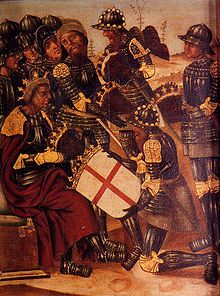Peter I of Aragon and Pamplona
Peter continued his father's close alliance with the Church and pursued his military thrust south against bordering Al-Andalus taifas with great success,[1] allying with Rodrigo Díaz de Vivar, known as El Cid, the ruler of Valencia, against the Almoravids.[2] According to the medieval Annales Compostellani Peter was "expert in war and daring in initiative",[3] and one modern historian has remarked that "his grasp of the possibilities inherent in the age seems to have been faultless.They decided to hastily restock Benicadell and retreat to Valencia via the coast, but were met at the Battle of Bairén by Muhammad's forces encamped on the high ground that reached almost to the sea.A small Almoravid fleet had been assembled from the southern ports, including Almería, and the Christians were trapped between arrow fire from the ships and the cavalry perched atop the hill.[15] The size of his forces so impressed a contemporary scribe in León that he remarked in the dating formula of a document of 12 February that "Peter, Aragonese king, with his infinite multitude of armed men, the city of Zaragoza, with Christ's banner, fought".For the siege he had a fortress built named Juslibol (a corruption of the Latin slogan Deus lo volt [God wills it] used by the First Crusaders) and ringed the city with banners bearing the cross.[17] In August he was conducting a razzia (raid) as far south as Alpenes and the river Ebro, but the campaign was eventually aborted due to insufficient cavalry.According to Peter's fueros, citizens were required to serve in local campaigns and castle defence, but were exempted from long-term service in the "host".[18] On 11 December 1102 Peter was in Estella on the border with Castile, perhaps seeking the aid of Alfonso VI after a particularly disastrous autumn for the Christians of eastern Spain.

King of AragonPamplonaSancho RamírezAlfonso the BattlerRoyal Monastery of San Juan de la PeñaAgnes of AquitaineBertha of AragonJiménezIsabella of UrgellSpanishAragoneseBasqueSaint PeterHoly SeevassalAl-AndalustaifasRodrigo Díaz de VivarValenciaAlmoravidsAnnales CompostellaniArabicCrónica de San Juan de la PeñaCounty of UrgellErmengol IVSobrarbeRibagorzabishopssiege of TudelaEstadaMontearagónMonzónAlmenarHuescaGallegaUrban IIexcommunicationTaifa of ZaragozaBattle of AlcorazSt George's CrossSardinianCastellónHistoria RodericiXàtivaYusuf ibn TashfinBattle of CuarteBattle of BairénAlmeríaBarbastroBishop of RodaDiocese of LleidaDiocese of UrgellSan Juan de la PeñaCrusade of 1101JerusalemPope Paschal IIFranceCataloniaFirst CrusadersZaragozaJuslibolDeus lo voltrazziaAlpenesriver EbroTudelafuerosCaparrosoSantacaraknight-serviceEstellaCastileAlfonso VIinfanzones BerthaLombardyCantar de mio CidVal d'Aran Ramiro II Petronillaname-poolHouse of BarcelonaKalendsGarcía RamírezRichard A. FletcherFelicia of RoucypatronymicBishop of BarcelonaChristopher TyermanchartersSancho (V)NavarreAlfonso IMonarchsAragonHouse of JiménezRamiro ISanchoRamiro IIPetronillaAlfonso IIPeter IIJames IPeter IIIAlfonso IIIJames IIAlfonso IVPeter IVJohn IMartinHouse of TrastámaraFerdinand IAlfonso VJohn IIFerdinand IIJoannaHouse of HabsburgCharles IPhilip IPhilip IIPhilip IIICharles IICharles IIIHouse of BourbonPhilip IVÍñigo Arista
